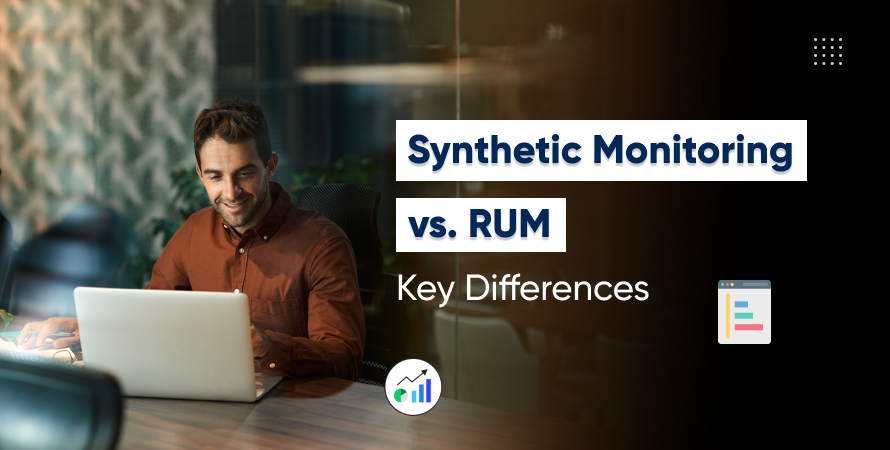Synthetic Monitoring vs. RUM: Key Differences



Introduction
In today’s fast-changing digital world, giving users a fast and smooth online experience isn’t just a nice-to-have—it’s a must. Whether you run an online store, a software platform, or a content-rich website, keeping your site running well is critical. From loading speed to Core Web Vitals and even how many people complete purchases, every second matters.
Website performance monitoring has become more than just a job for developers—it’s now a key part of business strategy. As user expectations grow and Google puts more focus on user experience in its search rankings, guessing your site’s performance is no longer good enough. That’s why two tools—Synthetic Monitoring and Real User Monitoring (RUM)—are so important.
In this blog, we’ll break down what Synthetic Monitoring and RUM are, how they’re different, where each is useful, and why using both together can give you the best results. Whether you’re part of a digital marketing agency, a web performance team, or a business owner aiming to improve Core Web Vitals, this guide will help you make smart choices.
What is Performance Monitoring in 2025?
Today, performance monitoring is about more than just checking if your website is online. It’s a complete approach that looks at how real people use your site, how fast it loads, and how well it meets Google’s user-focused standards, like Core Web Vitals.
For example, a digital marketing agency doesn’t just check if a site works—it also tracks how speed and performance affect things like search rankings, user behavior, and sales. In short, performance monitoring helps you understand and improve your entire online experience.
There are two main ways to do this: Synthetic Monitoring and Real User Monitoring (RUM). Each one gives you different kinds of useful information, and when used together, they give you a full picture of your website’s performance.
Understanding Synthetic Monitoring
Synthetic Monitoring- Meaning
Synthetic Monitoring, often called active monitoring, is a method where scripted transactions are executed from various locations around the world to simulate user behavior. These monitoring tests evaluate how your website or application performs under predefined conditions.
This type of monitoring doesn’t rely on real users. Instead, it uses bots or agents that test website functionality, page speed, and availability at regular intervals.
Pros of Synthetic Monitoring
- Proactive Issue Detection: It allows you to identify issues before they impact users.
- Controlled Environment: Offers consistent and repeatable test results, ideal for regression testing.
- Global Coverage: Monitor web availability from different regions.
- Useful in Pre-Deployment: Synthetic Monitoring is perfect for testing staging environments or new features.
Cons of Synthetic Monitoring
- Lacks Real-World Context: Cannot simulate unpredictable behaviors or diverse network conditions.
- No Behavioral Insight: Offers no visibility into actual user frustration or engagement.
Best Use Cases
- Testing SLAs (Service Level Agreements)
- Benchmarking performance across geographies
- Diagnosing availability issues
- Monitoring third-party integrations like CDNs or APIs
Understanding RUM (Real User Monitoring)
What is RUM?
Real User Monitoring, also called passive monitoring or end user monitoring, collects data from real people as they use your website. It shows how your site performs for actual users in everyday situations—on different devices, browsers, and internet connections.
RUM collects data continuously and reflects true performance as seen by your audience.
Pros of RUM
- Accurate UX Insights: See how your site performs for actual users, not simulations.
- Granular Data: Track performance by geography, browser, device, or even connection type.
- Crucial for Core Web Vitals: Google’s ranking metrics are based on real-world data, making RUM essential for SEO.
Cons of RUM
- Reactive: You only learn about performance issues after users experience them.
- Data Complexity: Large volumes of data may require advanced filtering and analysis tools.
Best Use Cases
- Core Web Vitals optimization
- Monitoring user experience in production environments
- Analyzing performance across user segments
- Supporting marketing campaign performance with live user feedback
Synthetic Monitoring vs. Real User Monitoring
Let’s break down the key differences between Synthetic Monitoring system and RUM:
| Feature | Synthetic Monitoring | Real User Monitoring (RUM) |
|---|---|---|
| Data Source | Simulated Transactions | Real User Interactions |
| Use Case | Pre-deployment & Testing | Live User Experience |
| Proactivity | Proactive | Reactive |
| Core Web Vitals Tracking | Limited | Comprehensive |
| Data Granularity | Fixed Test Cases | Real-World Conditions |
| Scalability | Easily Scalable | Requires User Traffic |
| Monitoring Web Regions | Global Agents Available | Depends on User Locations |
Each type plays a unique role. Synthetic Monitoring is ideal for preparing and testing your web environment, while RUM is indispensable for understanding the lived experiences of your users.
How to Combine Both for Maximum Insight
While businesses often pit Synthetic Monitoring and RUM against each other, the most successful digital marketing agencies know they are complementary, not competitive.
Here’s how combining them creates a robust monitoring strategy:
- Use Synthetic Monitoring to Establish Baselines: Run synthetic tests before launching campaigns or new features. It ensures the site is technically sound.
- Deploy RUM for Continuous Experience Monitoring: Once the site is live, RUM captures real performance metrics from real users.
- Cross-validate Findings: Use synthetic data to confirm anomalies discovered in RUM and vice versa.
- Optimize Based on Insights: Improve infrastructure with synthetic data; improve UX with RUM insights.
A blended approach offers both the reliability of synthetic testing and the authenticity of real user data.
Role in Core Web Vitals and SEO
Core Web Vitals—Largest Contentful Paint (LCP), First Input Delay (FID), and Cumulative Layout Shift (CLS)—are central to how Google ranks your site. Real User Monitoring is directly tied to how Google collects Core Web Vitals data, which means it’s non-negotiable for SEO.
Synthetic Monitoring still plays a role, especially in staging environments where you want to optimize LCP and CLS in isolation.
How They Support SEO
Synthetic Monitoring:
- Validates site speed after optimizations
- Helps with competitive benchmarking
RUM:
- Delivers real-world Core Web Vitals metrics
- Helps diagnose performance issues in key traffic segments
SEO isn’t just about keywords anymore—it’s about end user satisfaction. Monitoring web performance through both tools helps align technical SEO with user experience metrics.
Choosing the Right Tool: Key Considerations
When selecting a performance monitoring tool or service, consider:
- Business Objectives: Are you testing new features (synthetic) or optimizing live traffic (RUM)?
- Team Capabilities: Do you have internal expertise, or should you hire Core Web Vitals consultants?
- Volume of Users: Low-traffic sites may get limited RUM data, while synthetic testing works regardless.
- Tool Compatibility: Not all tools fit every tech stack. Ensure compatibility with your platform.
Popular Tools
Synthetic Monitoring Tools:
- Pingdom
- GTmetrix
- Uptrends
Real User Monitoring Tools:
- Google Analytics CrUX
- New Relic
- SpeedCurve
Each has strengths and trade-offs. Most enterprises and digital marketing agencies opt for a hybrid stack to ensure full coverage.
Common Mistakes to Avoid
- Using One Tool Exclusively: Over-reliance on either synthetic or RUM leads to blind spots.
- Testing Only the Homepage: Performance varies across pages and user journeys.
- Ignoring Third-party Elements: Ads, analytics, and scripts can hurt performance.
- Failing to Analyze Segments: Not all users are affected equally—use segmentation.
- Confusing Fast with Optimized: Speed isn’t the only factor—stability and interactivity matter too.
Avoiding these mistakes ensures your monitoring strategy is complete and effective.
Conclusion
Synthetic Monitoring and Real User Monitoring are not rivals—they are partners in building a high-performing, user-centric web experience. Synthetic Monitoring provides the assurance that your site works under ideal conditions, while RUM reveals how it performs in the real world.
For any business aiming to thrive in a digital-first economy, especially those focused on digital marketing, SEO, and Core Web Vitals compliance, a hybrid monitoring approach is essential.
Looking to optimize your site’s real-world performance and improve Core Web Vitals? Hire expert Core Web Vitals consultants to ensure your monitoring strategy drives real results.
Frequently Asked Questions (FAQs)
Yes. While RUM provides real-world metrics, Synthetic Monitoring can help validate performance improvements before they go live. It also allows for competitive benchmarking and global uptime tracking—both important for SEO.
Some advanced tools provide near real-time RUM data, but most aggregate data over periods ranging from minutes to hours. It’s excellent for trend analysis and Core Web Vitals tracking.
A digital marketing agency benefits from both. Synthetic Monitoring helps pre-launch performance validation, while RUM offers live insights into user engagement and site experience.
- Synthetic: Load homepage every 5 minutes from 5 countries, simulate form submissions, measure LCP under lab conditions.
- RUM: Measure actual CLS for users on mobile devices, track FID during high-traffic periods, analyze page speed by region.
Absolutely. Many companies use Synthetic Monitoring to catch issues before deployment and RUM to monitor ongoing user experience. Together, they offer 360-degree performance visibility.